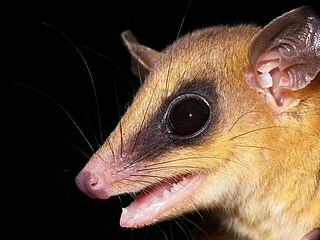
The nineteen species in the genus Marmosa are relatively small Neotropic members of the family Didelphidae. This genus is one of three that are known as mouse opossums. The others are Thylamys and Tlacuatzin, the grayish mouse opossum. Members of the genus Marmosops used to be called "slender mouse opossums", but are now just called "slender opossums". The six members of the Marmosa subgenus Micoureus, known as "woolly mouse opossums", were formerly considered to be a separate genus, but were moved into Marmosa in 2009. Based on a comparison of sequences of one mitochondrial and three nuclear genes, three new subgenera, Eomarmosa, Exulomarmosa and Stegomarmosa, were recognized by Voss et al. in 2014. Eomarmosa and Exulomarmosa, as well as Marmosa and Micoureus, are thought to be sister taxa, while Stegomarmosa is viewed as sister to Marmosa plus Micoureus. Exulomarmosa is a mostly trans-Andean clade.

Lundomys molitor, also known as Lund's amphibious rat or the greater marsh rat, is a semiaquatic rat species from southeastern South America.
Lagenoderus is a genus of leaf-rolling weevil that is noted for being strongly sexually dimorphic. Species of this genus are all known from Madagascar. Females of Lagenoderus had been assigned to a different genus, Phymatolabus Jekel, owing to confusion due to the species' sexually dimorphic nature.

Cryptonanus is a genus of opossums from South America. It includes five species found from Bolivia to Uruguay and eastern Brazil, one of which is now extinct. Although the first species were discovered in 1931, the genus was not recognized as distinct from Gracilinanus until 2005. It includes small opossums with generally grayish, sometimes reddish, fur that are mainly distinguished from other opossums by characters of the skull.
Kararhynchus is an extinct genus of beetles. Two new species, K. gratshevi and K. jurassicus, were described from the middle Late Jurassic epoch of Kazakhstan by A. A. Legalov in 2012.
Pseudobrienia is an extinct genus of beetles which existed in what is now Kazakhstan during the middle Late Jurassic epoch. It was described by A. A. Legalov in 2012, and the type species is P. rasnitsyni.

Ceutorhynchus is a genus of true weevils in the tribe Ceutorhynchini. There are at least 400 described species in Ceutorhynchus.
Homapoderus is a genus of weevils in the family Attelabidae. The genus was named and described by Legalov in 2003.
Homapoderus tamsi is a species of weevils of the family Attelabidae. It occurs in Equatorial Guinea, the Democratic Republic of the Congo and the island of Príncipe in São Tomé and Príncipe. The species was described as Parapoderus tamsi in 1937. It was placed into the genus Homapoderus by Legalov in the mid-2000s.
Haplorhynchites is a genus of leaf and bud weevils in the beetle family Attelabidae. There are about 11 described species in Haplorhynchites.
Pterocolus is a genus of thief weevils in the beetle order Coleoptera. There are about 16 described species in Pterocolus.

Involvulus is a genus of leaf and bud weevils in the beetle family Attelabidae. There are more than 40 described species in Involvulus.
Eugonus is a genus of fungus weevils in the beetle family Anthribidae. There are about 18 described species in Eugonus.
Stephanocleonus is a genus of cylindrical weevils in the beetle family Curculionidae. There are at least 70 described species in Stephanocleonus.
Caulophilus is a genus of true weevils in the beetle family Curculionidae. There are more than 20 described species in Caulophilus.
Acamptus is a genus of true weevils in the beetle family Curculionidae. There are about nine described species in Acamptus.






